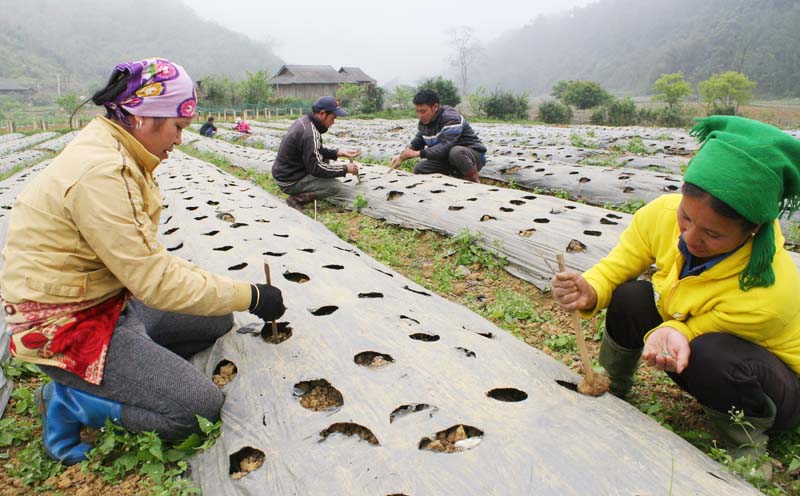



Members of Quyet Chien Cooperative, Quyet Chien commune (Tan Lac) grow
temperate vegetables in accordance with safety standards.
Ms. Dinh Thi Quyet, Chairman of Quyet Chien Cooperative, said: the climate
and land of these highland communes are suitable for the development of
cold-loving plants. Chayote has been on the soil of Quyet Chien for 10 years,
being grown in the fields of Bua Ma, Dong Lim, and Bua Lim, which is more
economical than other kinds of crops. Chayote can be harvested in 7 months
(from April to December every year). Each household grows from1,000 - 3,000 m2.
Every 1,000 m2, 30 kg per day can be collected with the current price of about
5,000 VND / kg, that means nearly 1 million VND can be earned.
Up to now, the total area of chayote growing has reached 64 hectares (Quyet
Chien accounts for 60 hectares, Lung Van accounts for 4 hectares). Of which,
the area of Cooperatives was 12.3 hectares, the households’ area was 39.7
hectares; the average productivity is 63 tons / year, the output reaches at
3,200 tons / year; the average selling price is 4,000 VND, the income reaches
at 250 million VND / hectare / year. Once the chayote plants are planted once,
its harvest will last from 2-3 years, which can reach 80 million VND / hectare
for the first year, from 100-120 million VND / hectare for the second year.
Since 2016, with the support from Korean Organization GNI, the district has
been experimenting with temperate vegetables such as radishes, onions, Chinese
cabbages, tomatoes, lettuces and cabbages to supply off-season vegetables to
the market. Up to now, 3.5 hectares have been developed.
At present, the growers harvest about 15 tons every day, of which 10
tons are consumed in Hanoi, the remaining is consumed in Vinh Phuc. For
temperate vegetables in the process of tested planting, the productivity and
yield seem satisfactory. Chayote planting for their tops is mostly picked up by
small traders for sale at some supermarkets and shops in Hanoi. Various
vegetables, radishes are mainly sold to Korean people living in Hanoi.
"Tan Lac district is planning the area of chayote growing
to an area of about 100 hectares in some communes of Quyet Chien, Lung Van, Ngo
Luong and Nam Son. With the support of GNI organization and district rural
development project in association with safe vegetable development under
VietGap standards, the district has expanded the area of growing temperate
vegetables while promoting the implementation of policies to support production
development, attaching importance to attracting enterprises to participate in
association among growing, processing and consuming chayote and temperate
vegetables, "said Mr. Bui Van Nho, vice chairman of Tan Lac District
People's Committee.